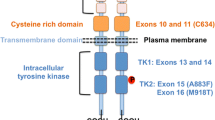Abstract
Background
Twenty-five percent of medullary thyroid cancer (MTC) cases are hereditary. The ideal age for prophylactic thyroidectomy is based on the specific RET mutation involved. The purpose of this study was to determine whether such age-appropriate prophylactic thyroidectomy results in improved disease-free survival.
Methods
Twenty-eight patients underwent thyroidectomy for hereditary MTC at our institution. Age-appropriate thyroidectomy was defined according to the North American Neuroendocrine Tumor Society (NANETS) guidelines. Patients who had age-appropriate surgery (group 1, n = 9) were compared to those who had thyroidectomy past the recommended age (group 2, n = 19).
Results
The mean age was 13 ± 2 years, and 61 % were female. Patients in group 1 were younger than in group 2 (4 ± 1 vs. 17 ± 2 years, p < 0.01). There were no significant differences in gender or RET mutation types between these two groups. Group 1 patients were cured with no disease recurrence compared with group 2 patients who had a 42 % recurrence rate (p = 0.05). Subanalysis of group 2 identified that patients who underwent surgery without evidence of disease did so at a shorter period following the guidelines compared with those who underwent therapeutic surgery (2 ± 2 vs. 16 ± 2 years, p = 0.01) and had longer disease-free survival (100 vs. 27 %, p = 0.005).
Conclusions
Patients with hereditary MTC should undergo age-appropriate thyroidectomy based on RET mutational status to avoid recurrence. Patients who are past the recommended age should have surgery as early as possible to improve disease-free survival.



Similar content being viewed by others
References
Chen H, Sippel RS, O’Dorisio MS, et al. The North American Neuroendocrine Tumor Society consensus guideline for the diagnosis and management of neuroendocrine tumors: pheochromocytoma, paraganglioma, and medullary thyroid cancer. Pancreas. 2010;39(6):775–83.
Sippel RS, Kunnimalaiyaan M, Chen H. Current management of medullary thyroid cancer. Oncologist. 2008;13(5):539–47.
Greenblatt DY, Chen H. Palliation of advanced thyroid malignancies. Surg Oncol. 2007;16(4):237–47.
Chen H, Roberts JR, Ball DW, et al. Effective long-term palliation of symptomatic, incurable metastatic medullary thyroid cancer by operative resection. Ann Surg. 1998;227(6):887–95.
Moley JF, Lairmore TC, Phay JE. Hereditary endocrinopathies. Curr Prob Surg. 1999;36(9):653–762.
Hansford JR, Mulligan LM. Multiple endocrine neoplasia type 2 and RET: from neoplasia to neurogenesis. J Med Genet. 2000;37(11):817–27.
Donis-Keller H, Dou S, Chi D, et al. Mutations in the RET proto-oncogene are associated with MEN 2A and FMTC. Human Mol Genet. 1993;2(7):851–6.
Pinchot SN, Sippel RS, Chen H. Multi-targeted approach in the treatment of thyroid cancer. Ther Clin Risk Manag. 2008;4(5):935–47.
Eng C, Clayton D, Schuffenecker I, et al. The relationship between specific RET proto-oncogene mutations and disease phenotype in multiple endocrine neoplasia type 2. International RET mutation consortium analysis. JAMA. 1996;276(19):1575–9.
Kouvaraki MA, Shapiro SE, Perrier ND, et al. RET proto-oncogene: a review and update of genotype–phenotype correlations in hereditary medullary thyroid cancer and associated endocrine tumors. Thyroid. 2005;15(6):531–44.
Skinner MA, Moley JA, Dilley WG, et al. Prophylactic thyroidectomy in multiple endocrine neoplasia type 2A. N Eng J Med. 2005;353(11):1105–13.
O’Riordain DS, O’Brien T, Weaver AL, et al. Medullary thyroid carcinoma in multiple endocrine neoplasia types 2A and 2B. Surgery. 1994;116(6):1017–23.
Schreinemakers JMJ, Vriens MR, Valk GD, et al. Factors predicting outcome of total thyroidectomy in young patients with multiple endocrine neoplasia type 2: a nationwide long-term follow-up study. World J Surg. 2010; 34(4):852–60.
Machens A, Niccoli-Sire P, Hoegel J, et al. Early malignant progression of hereditary medullary thyroid cancer. N Eng J Med. 2003;349(16):1517–25.
Wolfe HJ, Melvin KE, Cervi-Skinner SJ, et al. C-cell hyperplasia preceding medullary thyroid carcinoma. N Eng J Med. 1973;289(9):437–41.
Kloos R, Eng C, Evans D, et al. Medullary thyroid cancer: management guidelines of the American Thyroid Association. Thyroid. 2009;19(6):565–612.
Acknowledgment
Supported by the University of Wisconsin Department of Surgery NIH T32 Training Grant (5 T32 DC 9401-2).
Disclosure
None.
Author information
Authors and Affiliations
Corresponding author
Rights and permissions
About this article
Cite this article
Shepet, K., Alhefdhi, A., Lai, N. et al. Hereditary Medullary Thyroid Cancer: Age-Appropriate Thyroidectomy Improves Disease-Free Survival. Ann Surg Oncol 20, 1451–1455 (2013). https://doi.org/10.1245/s10434-012-2757-9
Received:
Published:
Issue Date:
DOI: https://doi.org/10.1245/s10434-012-2757-9




